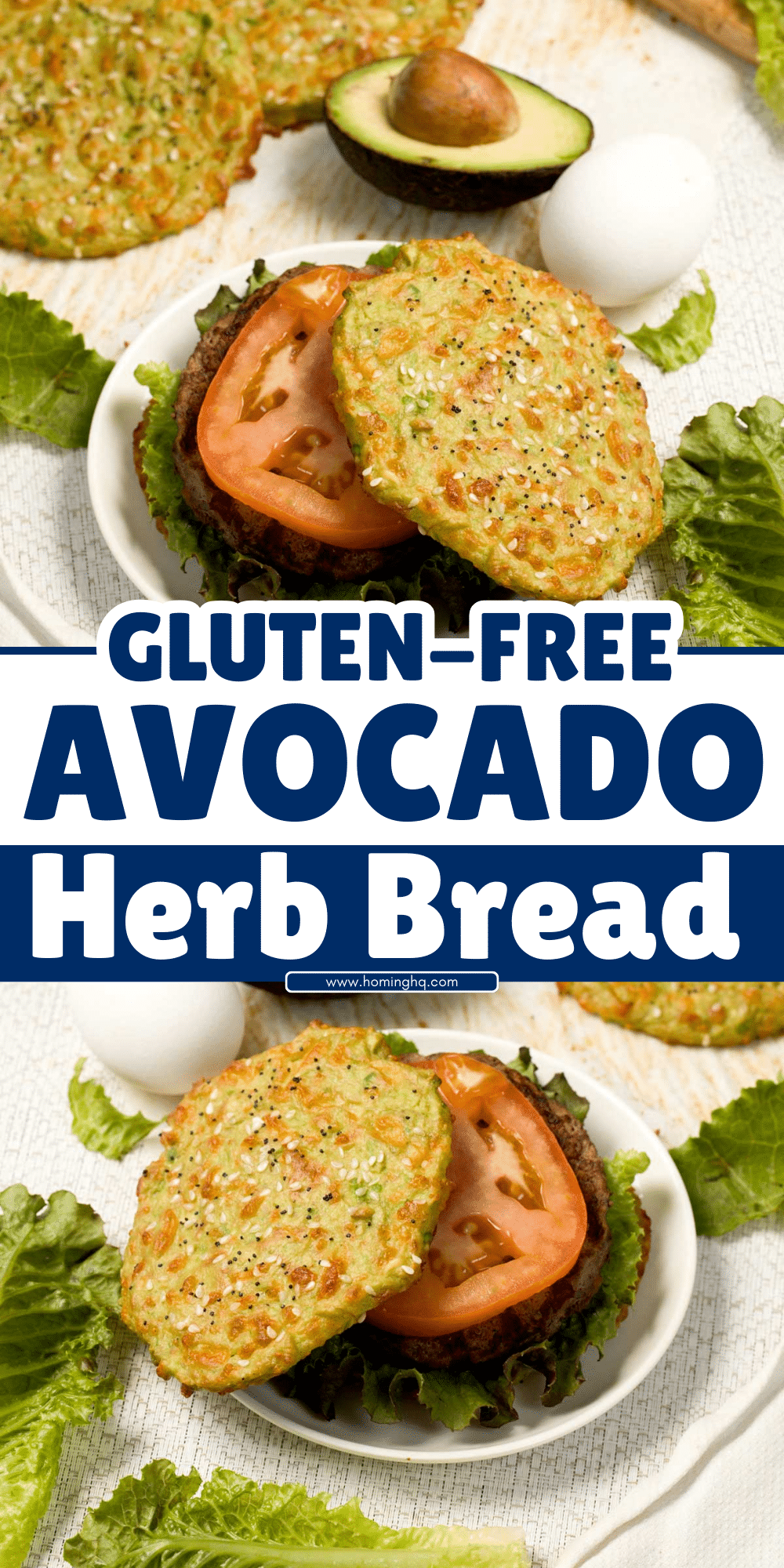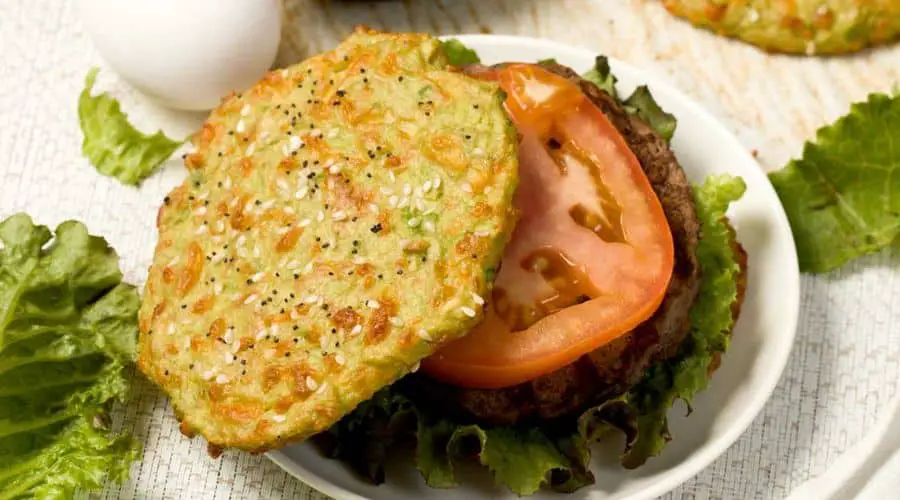Gluten-Free Avocado Herb Bread is a fresh and healthy take on traditional bread that will elevate your gluten-free baking.
This flavorful loaf combines the creamy richness of ripe avocado with the vibrant taste of fresh herbs, creating a delicious bread that’s perfect for anyone looking for a healthier, gluten-free alternative.
Whether you’re living with gluten sensitivity, celiac disease, or simply enjoy exploring different types of bread, this avocado herb bread is sure to become a favorite in your kitchen.
It’s moist, light, and packed with nutrients, making it a fantastic choice for breakfast, a savory snack, or as a side for your favorite meals.

Why Choose Gluten-Free Bread?
When it comes to bread, many people are moving towards gluten-free options due to health concerns or dietary choices. For those with gluten sensitivity or celiac disease, avoiding gluten is essential.
However, even if you’re not gluten intolerant, gluten-free bread can still be a nourishing and tasty alternative, offering new flavors and textures.
In addition to being a great choice for those with dietary restrictions, gluten-free bread can also be easier on digestion, providing a lighter option compared to traditional wheat-based bread.
With the right ingredients, gluten-free bread can be just as delicious and satisfying. And, unlike some store-bought gluten-free options, homemade gluten-free bread—like this avocado herb bread—offers superior freshness and flavor, making it a standout addition to any diet.
Key Ingredients for Gluten-Free Avocado Herb Bread
To create a soft and flavorful gluten-free bread, it’s essential to use the right ingredients.
Here’s a breakdown of the key ingredients that make this avocado herb bread so unique and delicious:
Avocado
Avocado serves as the secret ingredient that makes this bread incredibly moist and rich.
Packed with heart-healthy fats, fiber, and vitamins, avocado not only adds creaminess to the dough but also boosts the nutritional value of your bread. It’s an excellent alternative to oils or butter, providing a lighter texture while enhancing the overall flavor.
Gluten-Free Flour
The base of any gluten-free bread is the flour. For this recipe, a combination of gluten-free flours—such as rice flour, almond flour, or a gluten-free all-purpose flour blend—works best to achieve the perfect texture.
These flours provide the structure needed for the bread without the use of gluten. Choosing a high-quality gluten-free flour blend ensures your bread has the best texture and flavor.
Herbs
Fresh herbs are the flavor stars of this recipe. Herbs like rosemary, thyme, parsley, and basil bring a burst of freshness and depth to the bread. You can customize the herb combination based on your preferences or what you have available in your kitchen.
These aromatic herbs pair perfectly with the creamy avocado, making every bite flavorful and aromatic.
Other Ingredients
Along with the avocado, gluten-free flour, and herbs, this bread also requires eggs to bind the ingredients together and provide structure. Olive oil adds a subtle richness, while baking powder helps the bread rise, giving it a light and fluffy texture.
A pinch of salt enhances the natural flavors of the bread, ensuring it’s balanced and delicious. You can also add optional ingredients like sunflower seeds or chopped nuts for extra texture and flavor.
Step-by-Step Instructions

1. Preheat the Oven and Prepare the Pan
Start by preheating your oven to 350°F (175°C). While the oven heats up, grease a loaf pan with olive oil or line it with parchment paper to ensure the bread doesn’t stick. This step will also make cleanup a breeze.
2. Prepare the Wet Ingredients
In a medium-sized bowl, mash the avocado until it’s smooth and creamy. You can use a fork or potato masher for this. Once mashed, whisk the eggs in a separate bowl and then add them to the avocado. Stir in the olive oil, ensuring all the wet ingredients are well combined and smooth.
3. Mix the Dry Ingredients
In a separate bowl, combine the gluten-free flour, baking powder, salt, and your choice of herbs (e.g., rosemary, thyme, parsley). Stir well to ensure that the herbs are evenly distributed throughout the flour mixture.
4. Combine Wet and Dry Ingredients
Slowly add the dry ingredients into the wet mixture, stirring gently as you go. Be careful not to overmix. You want a smooth, consistent dough that’s slightly thick but not too dry. If the dough feels too thick, you can add a little water or olive oil to reach the right consistency.
5. Baking the Bread
Pour the dough into the prepared loaf pan and spread it evenly. Place the pan in the oven and bake for 45-50 minutes. The bread should rise nicely, and a toothpick inserted into the center should come out clean when it’s fully baked. If the top begins to brown too quickly, you can cover it with aluminum foil and continue baking.
6. Cool and Slice
Once the bread is baked, remove it from the oven and let it cool in the pan for about 10 minutes. Afterward, transfer it to a wire rack to cool completely before slicing. This will ensure the bread maintains its shape and doesn’t become too crumbly. Slice and enjoy!
Tips for Perfect Gluten-Free Avocado Herb Bread
Use Ripe Avocados
For the best results, make sure your avocados are ripe. This will make the mashing process easier and help create a smoother, creamier bread texture. Ripe avocados also contribute more flavor and richness to the bread.
Don’t Overmix the Dough
Gluten-free bread dough can become dense if overmixed. Stir the ingredients until they are just combined to avoid tough, heavy bread. A few gentle folds are all it takes!
Adjust the Herbs to Your Taste
The beauty of this bread lies in the flexibility of the herbs. Feel free to adjust the herbs to match your personal preferences. If you like stronger flavors, add more rosemary or thyme. For a milder, fresher taste, parsley or basil will work beautifully.
Add-ins for Extra Texture
For added crunch or flavor, consider folding in ingredients like sunflower seeds, pumpkin seeds, or chopped nuts (e.g., walnuts or almonds). These will add a wonderful contrast to the soft, moist texture of the bread.
Monitor the Baking Time
Baking times may vary depending on your oven, so check the bread around the 45-minute mark. If you find that the top is browning too much, but the center isn’t fully baked, cover the pan loosely with foil and continue baking until done.
Let It Cool Completely
It’s important to let the bread cool completely before slicing. This helps it set properly and prevents it from being too crumbly when you cut into it. Patience is key for the perfect loaf!
Store for Freshness
Store any leftover bread in an airtight container at room temperature for up to 3 days. You can also freeze slices of the bread for longer storage—simply wrap each slice in plastic wrap and place them in a freezer bag. When you’re ready to eat, just toast the slices for a quick, fresh treat.
Nutritional Benefits of Gluten-Free Avocado Herb Bread
Gluten-Free Avocado Herb Bread is not only delicious but also packed with essential nutrients that make it a healthy option for anyone, whether they follow a gluten-free diet or not. Here’s a breakdown of the key nutritional benefits:
Rich in Healthy Fats
Avocado, the star ingredient in this bread, is an excellent source of monounsaturated fats, which are heart-healthy and can help lower bad cholesterol levels. These healthy fats also contribute to the bread’s creamy texture and provide lasting energy.
Packed with Fiber
Avocado is also a great source of dietary fiber, which aids in digestion and helps maintain healthy blood sugar levels. The gluten-free flour used in this recipe (such as almond flour or rice flour) adds additional fiber, making this bread a great choice for those looking to improve their digestive health.
Vitamins and Minerals
Avocados are rich in vitamins like vitamin K, folate, vitamin E, and several B vitamins. These nutrients support immune function, skin health, and overall well-being. Additionally, the herbs used in this recipe, such as parsley and rosemary, are packed with antioxidants that promote health and combat inflammation.
Gluten-Free and Lower in Carbs
For those following a gluten-free diet, this bread provides a tasty alternative to traditional bread, which often contains refined grains and gluten. It’s also generally lower in carbs compared to regular bread made with wheat flour, making it suitable for those who are watching their carbohydrate intake.
Protein from Eggs
The eggs used in this recipe provide a good source of protein, which is essential for muscle repair and growth. They also contribute to the structure and fluffiness of the bread, ensuring that it maintains its light, airy texture.
In short, Gluten-Free Avocado Herb Bread offers a range of health benefits, from healthy fats and fiber to essential vitamins and minerals, all while being free of gluten and refined sugars.
Conclusion
Gluten-Free Avocado Herb Bread is a delightful, nutritious alternative to traditional bread, offering a flavorful combination of creamy avocado and aromatic herbs. Whether you’re following a gluten-free diet or simply want to enjoy a healthier, homemade loaf, this bread is sure to satisfy. It’s easy to make, full of healthy fats, fiber, and vitamins, and can be enjoyed at any time of day, whether as a snack, a side dish, or a toasted breakfast treat. So, give this recipe a try and enjoy the wholesome goodness of this homemade, gluten-free loaf that’s as nourishing as it is delicious.
Frequently Asked Questions
1. Can I make this bread vegan?
Yes, you can make this bread vegan by replacing the eggs with a flaxseed egg or chia seed egg substitute. For every egg, mix 1 tablespoon of ground flaxseeds or chia seeds with 2.5 tablespoons of water, let it sit for a few minutes to thicken, and use it in place of each egg.
2. Can I freeze this bread?
Absolutely! This bread freezes well. Simply slice it before freezing, and wrap the slices in plastic wrap or place them in an airtight container. To enjoy, just toast the slices straight from the freezer.
3. Can I substitute the avocado for something else?
If you don’t have avocado or want to try a different flavor, you can substitute with mashed sweet potato or pumpkin puree. These options will add a similar moisture and richness to the bread.
4. How do I know when the bread is done baking?
To check if the bread is fully baked, insert a toothpick into the center. If it comes out clean or with just a few crumbs, the bread is ready. If the toothpick comes out with wet batter, continue baking and check again in a few minutes.
5. Can I add other herbs or spices to the recipe?
Absolutely! Feel free to experiment with different herbs like thyme, oregano, or basil. You could even add a pinch of garlic powder or onion powder for an extra savory kick. The beauty of this bread is that it’s versatile and customizable to your tastes.

Gluten-Free Avocado Herb Bread
Equipment
- 1 loaf pan (9×5 inches)
- 1 Mixing Bowl (Medium)
- 1 whisk
- 1 Fork or potato masher
- 1 spoon or spatula for mixing
- 1 Measuring Cup and Spoons
Ingredients
- 1 large Avocado mashed
- 3 large Eggs
- 1/4 cup Olive oil
- 2 cups Gluten-free flour all-purpose or a mix
- 1 tablespoon Baking powder
- 1 teaspoon Salt
- 1/4 cup Fresh herbs rosemary, thyme, parsley, or basil
- 1 teaspoon Optional Sunflower seeds or nuts for texture
Instructions
- Preheat the oven to 350°F (175°C). Grease a loaf pan with olive oil or line with parchment paper.
- In a medium bowl, mash the avocado until smooth. Add the eggs and olive oil, whisking together until well combined.
- In a separate bowl, mix the gluten-free flour, baking powder, salt, and fresh herbs.
- Gradually add the dry ingredients to the wet mixture, stirring gently to combine. If the dough is too thick, add a little water or olive oil.
- Pour the mixture into the prepared loaf pan and smooth the top.
- Bake for 45-50 minutes, or until a toothpick inserted into the center comes out clean.
- Remove from the oven and let cool in the pan for 10 minutes, then transfer to a wire rack to cool completely before slicing.
Notes
- Ensure the avocado is fully ripe for a creamy texture.
- If the top of the bread starts to brown too quickly, cover it with foil and continue baking.
- The bread stores well for up to 3 days at room temperature in an airtight container, or you can freeze slices for longer storage.
- Experiment with different herbs for variety or add in nuts and seeds for extra texture.
- For a vegan version, replace the eggs with flax or chia seed eggs.

